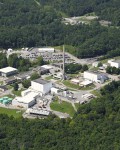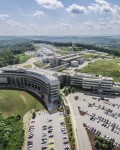The drive is intensifying to encourage research partnerships between Neutron Sciences and private industry.
Such partnerships, a long-term strategic goal set by the DOE’s Basic Energy Sciences Advisory Committee, will deliver industry and its technological problems to SNS and HFIR, where joint laboratory–industry teams can use the unparalleled resources available here to resolve them.
“SNS is a tremendous facility. It has the potential to have a couple of thousand user visits a year and, if they build another target station in the future, you’re probably talking about 4000 user visits a year,” said former SHUG Chair Michael Crawford in an interview. Crawford is a member of the research staff in Central Research and Development at DuPont in Wilmington, Delaware. As a long-time industrial user of DOE facilities, Crawford is enthusiastic about the relevance of neutron scattering to industrial research.
Crawford spoke about the strategies needed to attract new users to SNS and HFIR—particularly users from industry.
“Neutron Sciences should make more expertise available to industry, so that when people have an idea for an experiment, there is a well-defined route to get information, to help them plan the experiment, and even to help them write a proposal and analyze their data,” Crawford said.
“Many people don’t know that if you want to do neutron experiments and you use DOE facilities, you don’t have to pay for their use,” said Crawford. “You just have to write a proposal, and if it is accepted, you are granted the time.”
“Some people learn this process in grad school by coming along with their professors and working with people at the labs. But for researchers in industry who come in cold, who have never done this type of research before, it’s more difficult. I think more of the burden needs to shift over to the lab to provide that kind of expertise.”
Crawford suggested the following areas as ideal for collaborations with industry:
Polymer science and nanocomposites. This area of nanotechnology seeks to understand how nanoparticles can be used to improve the properties of polymers. Applications nclude everything from displays to clothing to parts of automobiles.
Materials science. Neutron scattering has wide applications in many types of materials science. For example, neutron scattering is an excellent means of studying materials being developed by the electronics industry for use in data storage. Researchers have used neutron reflectometry to study the magnetic properties of thin films used as data storage media.
Pharmacology. The pharmaceutical industry can use neutrons to determine the structures of biological molecules to better understand how they interact with drug molecules.
Stress analysis. Neutrons are ideal tools for analyzing the behavior of materials under applied or residual stress. The results are important for the automobile and airline industries, where there is an obvious need to understand the failure mechanisms of structural components.
Imaging with neutrons. Neutron radiography can provide images of the distributions of chemical compounds in functioning devices. For example, the automotive industry has used neutron radiography to better understand the operation of fuel cells.
Energy storage. Neutrons reveal the structure and dynamics of materials for devices such as batteries to improve their performance for applications such as long-term storage of energy from wind turbines and photovoltaic modules.
The high intensity of the neutron beams will have a significant impact on the attractiveness of SNS and HFIR for industry in the future, Crawford noted. “Some of the things you can do here are just significantly better than you can do anywhere else in the world. The nature of the source and its power are going to have a big impact on industrial applications of neutron scattering, and its size is going to make neutron scattering accessible to many more people.
“Some of the newer instruments coming online, such as the chemical spectrometers, are unique. They are going to provide new techniques for people in the chemistry community and in industry to look at things that in the past you did using standard techniques of vibrational spectroscopy. Now there will be a much greater capability here, especially when the spectroscopy is coupled with diffraction techniques. This powerful combination will provide vibrational and structural information at the same time.”
Crawford said SNAP (Spallation Neutrons and Pressure Diffractometer) will have an impact on the geochemistry community, and the inelastic spectrometers will certainly have an impact on condensed matter research. “Having all of these extremely powerful inelastic spectrometers here is going to really impact studies of topics such as magnetism. The ability to study magnetic or vibrational excitations in materials in strong magnetic fields is also very important. It’s going to be exciting.”
Crawford noted that “to a large extent, current SNS users are veteran neutron scatterers. Many of them have used other U.S. neutron scattering facilities—NIST, HFIR, the High Flux Beam Reactor at Brookhaven, LANSCE, or IPNS. This is the newest and most powerful facility in the world so these researchers are naturally attracted to it, and there are also people coming here from overseas as well for the same reason.” However, Crawford stressed that it is important to expand the neutron user community beyond the veteran users and attract the best science from academia, the national labs, and industry.The high intensity of the neutron beams will have a significant impact on the attractiveness of SNS and HFIR for industry in the future, Crawford noted. “Some of the things you can do here are just significantly better than you can do anywhere else in the world. The nature of the source and its power are going to have a big impact on industrial applications of neutron scattering, and its size is going to make neutron scattering accessible to many more people.
Crawford pointed to JINS (Joint Institute of Neutron Sciences) as another asset that will attract industrial users. “It is a great idea to bring in long-term visitors, such as students and faculty, during the summers to provide stimulating interactions with neutron scattering experts from ORNL and other institutions. I am looking into the possibility of encouraging some industrial participation in JINS. I think that these are really good avenues to attract researchers to Oak Ridge, not only as short-term users of the facilities but for longer periods of time. In that way they will contribute not only to the quality of the science here but to the culture as well.”
SNS and HFIR are Office of Science user facilities funded by the U.S. Department of Energy (DOE) Office of Basic Energy Sciences.





